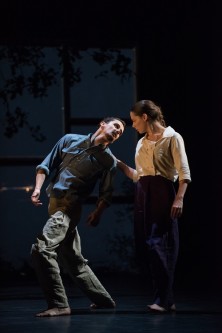
 United Kingdom Keaton Henson, Young Men: BalletBoyz, Sadler’s Wells, London, 6.10.2015 (J.O’D)
United Kingdom Keaton Henson, Young Men: BalletBoyz, Sadler’s Wells, London, 6.10.2015 (J.O’D)
Dancers: Andrea Carrucciu, Simone Donati, Flavien Esmieu, Marc Galvez, Oxana Panchenko, Edward Pearce, Leon Poulton, Harry Price, Matthew Rees, Matthew Sandiford, Bradley Waller, Jennifer White
Musicians: Terry Davies (conductor) Ben Foskett (arranger), Reinoud Ford (orchestral fixer), John Moore (drums and electronics), Chris Goodman, Harry Penny (clarinets), Nick Hougham, James Pillai, Phillippa Slack (horns), Richard Uttley (piano), Rowan Bell, Rakhvinder Singh (violins), Ruth Gibson, Simon Tandree (violas), Richard Birchall, Reinoud Ford (cellos), Dave Brown (double bass)
Choreography: Iván Pérez
Lighting Designer: Jackie Shemesh
Costume Design: Carlijn Petermeijer
What was good and not so good about Young Men when it premiered at Sadler’s Wells in January is good and not so good now. What improves it considerably is a change to the order of scenes in the second half. In January, an apparently last-minute decision was taken to end the piece with the bombastic Battlefield Landscape. Now it ends with Homecoming, in which a returning soldier fails to comfort, or be comforted by, two women. The inclusion of these women in the piece was and is one of its strongest points. Their presence in the final moments is moving and dramatically appropriate.
Once again, it is in its quieter moments, its details, above all in the first half, that Young Men works best. The BalletBoyz show a cooperation in their movements that might echo the cooperation of soldiers fighting and dying together in the First World War that the piece was created to commemorate. In the opening scene, Aftermath of War, choreographer Iván Pérez makes use of weighted lifts. As one of the women (Oxana Panchenko) moves between them, hobbling and crawling in grief that is bewildered but contained, the men support each other’s heavily falling bodies. If they resemble sleepwalkers, they know automatically where to place a hand, arm or shoulder to prop each other up. The lighting (Jackie Shemesh) and the costumes (Carlijn Petermeijer) contribute to a very real sense of corporality. Keaton Henson’s commissioned score, performed on stage by musicians behind a screen, contributes the sounds of piano and bells.
Training a Soldier shows the cooperation of drill. When the other women (Jennifer White) searches among them in Desperate Disguise, the men can only collude in treating her as an intruder from another world. After his stark solo in Shell Shock, another man tries to calm Andrea Carrucciu’s twitching body by hugs before the others simply put him back into his clothes. Later on, an officer uses the hug to force each man into subjection. In a scene that is similar to one from the film Nicholas and Alexandra, this officer then makes a pistol of his hand and shoots himself in the mouth with it.
As the second half of the piece continues, something seems to be missing. It is as if choreographer and composer have decided only to go so far into their subject. You feel this most in Battlefield Landscape. Starting with an effective use of light, shadow and leaping bodies, it builds to a climax in which the dancers do little more than jump through beams of light and run in circles around the stage. Afterwards they stand in a line, waiting to be applauded.
Homecoming does much to correct this false note. A scrim descends. Through it we see two women. The man who comes back to them from the battlefield tries to be the man he was before he went away. He lifts them. Soon it becomes clear that instead of supporting them, he is being supported by them. Eventually, he sinks to the floor to be cradled in the arms of one as the other looks helplessly on.
John O’Dwyer
